|
The Devil's Den Battle
of Gettysburg
Battle of Gettysburg Devil's Den The Round Tops, Little Round Top, Big Round Top, Nicknamed
The Slaughter Pen, Plum Run Valley The Valley of Death, General Hood's Division Charged The Wheatfield History and Map
Devil's Den and Battle of Gettysburg
Devil's Den
The second day’s battle of Gettysburg was the largest and costliest of the three days. The second
day’s fighting (at Devil’s Den, Little Round Top, The Wheatfield, The Peach Orchard, Cemetery Ridge, Trostle’s
Farm, Culp’s Hill and Cemetery Hill) involved at least 100,000 soldiers of which roughly 20,000 were killed, wounded,
captured or missing. The second day in itself ranks as the 10th bloodiest battle of the Civil War.
| Battle of Devil's Den, Gettysburg |
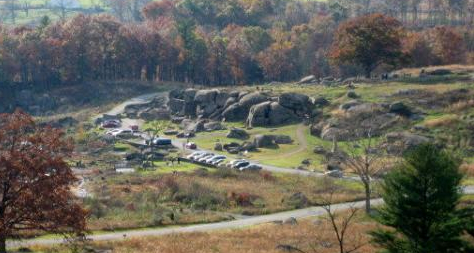
|
| View of Devil's Den |
| Gettysburg and Devil's Den |
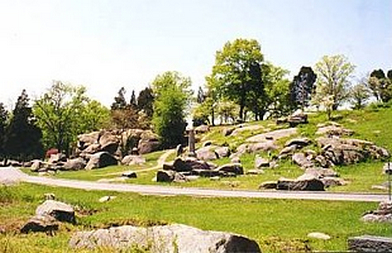
|
| Devil's Den from the Valley of Death |
Summary
Devils Den, a boulder-strewn Gettysburg Battlefield hill, was used by artillery and infantry (e.g.,
snipers) during the second day of the Battle of Gettysburg, July 2, 1863.
On July 2, 1863, Smith's Union battery used the hill to counterfire on Confederate artillery prior to McLaws'
Assault at 5:30 pm. Against Hood's Assault that started at 4 pm, Devils Den was defended by Birney's 1st Division as the far
left position from The Peach Orchard Salient of the III Corps. The hill was captured when the "First Texas Regiment, having
pressed forward to the crest of the hill and driven the enemy from his battery", and Anderson's Confederates used the hill
for the first attack on The Wheatfield. From near the Slaughter Pen, the 40th New York Volunteer Infantry Regiment forced
the 2nd & 17th Georgia regiments of Benning's Brigade to retreat to Devils Den.
| Devil's Den and Battle of Gettysburg |
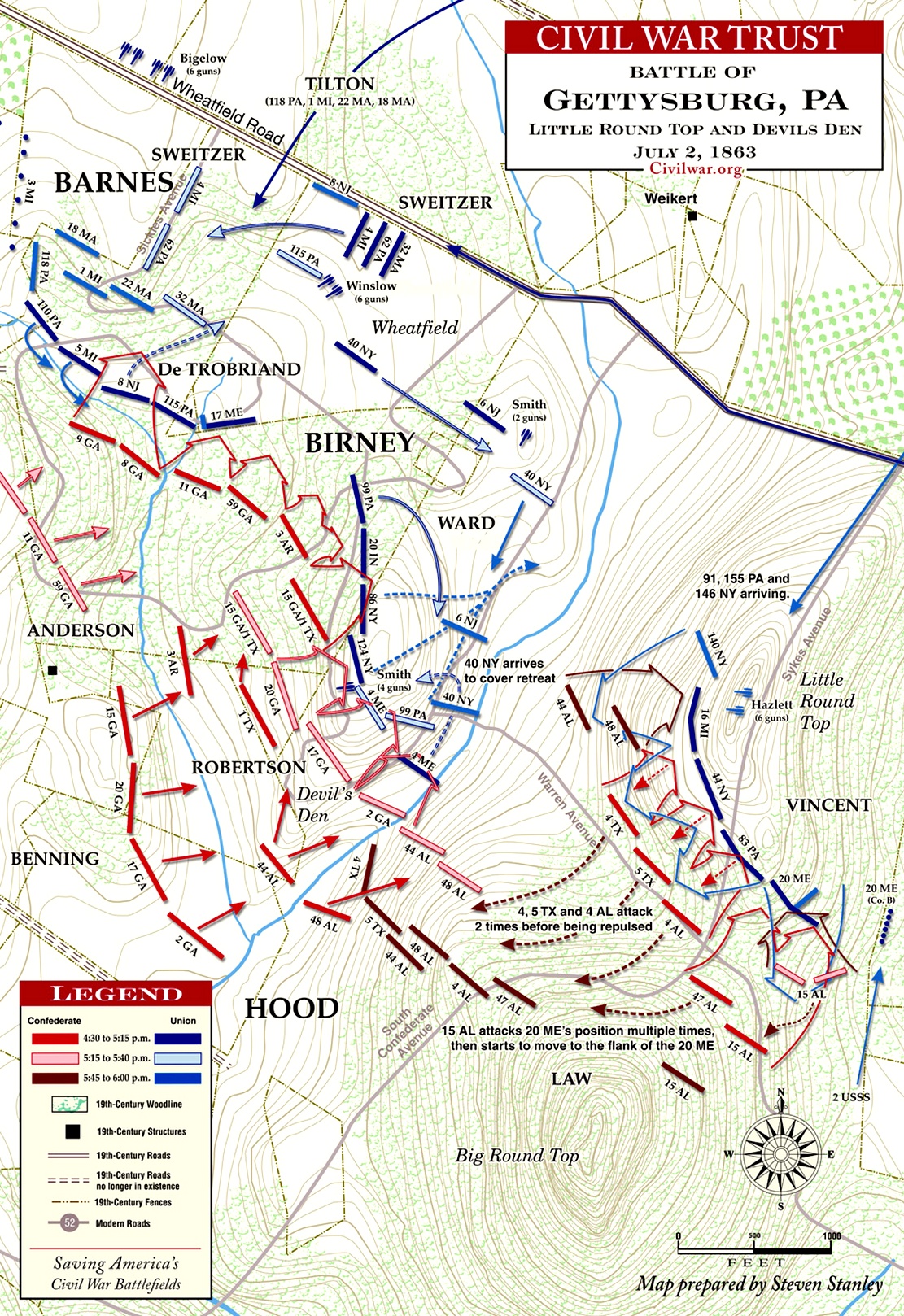
|
| Battle of Devil's Den, Second Day, Battle of Gettysburg, July 2,1863 |
History
Located 900 yards west of Little Round Top, this unique landmark lies at the southern end of a forested ridge that
separates Plum Run Valley from the Wheatfield. Considered a curiosity by local residents long before the battle, the huge
granite formations and steep cliffs of Devil's Den provided height and protection for the Union battery placed on the summit. On
the afternoon of July 2, Captain James Smith's 4th New York Battery was stationed here on the extreme left of General Sickles'
advanced Third Corps line. From the summit, Smith could survey the Slyder and Bushman farms up to Warfield Ridge where Longstreet's Confederates readied themselves for the afternoon attack.
Though the position Smith held appeared formidable, there was a major weakness- there was only room for four of Smith's six
guns and no place to safely park the artillery limbers that carried the ammunition chests. Ammunition would have to be run
up the steep hill from the limbers parked on the eastern side of the den. With guns and gunners crowding the summit, there
was precious little room for anything else including infantry support. Smith and his officers hoped that if the Confederates
attacked, they would do so on the west side through a triangular field and not from another direction. Otherwise, they would
be trapped.
| Devil's Den |
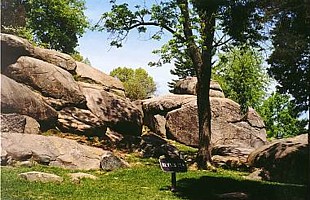
|
| Rock formations at Devil's Den |
| 4th New York Battery |
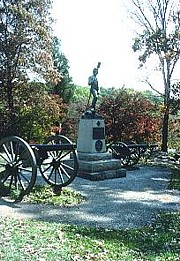
|
| 4th New York Battery |
Smith's worse fears came true when Confederates struck the den from three
directions at once. Southerners were awe struck by the terrible nature of the ground. One veteran of the battle described
it as, "a wild, rocky labyrinth which, from its weird, uncanny features, has long been called by the people of the vicinity
the 'Devils Den.' Large rocks from six to fifteen feet high are thrown together in confusion over a considerable area and
yet so disposed as to leave everywhere among them siding passages carpeted with moss. Many of the recesses are never visited
by the sunshine, and a cavernous coolness pervades the air within it." Pastures around the base of the Den were filled with
piles of rocks and large boulders that caused battle formations to fragment. Officers lost control of their commands and soldiers
lost their way in this wild garden of stone. Men scrambled behind boulders for protection from the shower of bullets, shell
and canister.
The 4th New York initially dueled with Confederate batteries near the Emmitsburg
Road three quarters of a mile to the west until Confederate infantry from Brig. General Jerome Robertson's brigade and Brig.
General Henry L. Benning's brigade closed in on their position.
The fighting was at close range. Repeated charges by the 15th Georgia and
the 1st Texas Infantry through a triangular-shaped field on the west side of Devil's Den wore down Smith's artillerymen. When it appeared that the guns were in danger of capture, a desperate counterattack
by the 124th New York Infantry stalled the Southern assault. The aggressive Union defense made General Robertson believe that
he was outnumbered six to one, but he rallied his Texans with the 3rd Arkansas Infantry for one last effort. At this same
time, Confederates were successfully driving into the Union rear around the den. With no help in sight and his infantry support
withdrawing, Smith knew he would lose his guns. "The men are instructed to remove all implements if they are compelled to
fall back, so that our pieces may not be turned against us. Alas, we are flanked by the enemy moving through the gorge (and)
our pieces are now useless."
Shouting the famous rebel yell, the 1st Texas charged up the triangular
field to finally take the summit. Georgian and Texan alike swarmed over Devil's Den and took three of Smith's guns as prizes.
One enthused Texan stood upon one of the cannon and triumphantly waved the flag of the 1st Texas at the retreating Northerners.
| Devil's Den, Gettysburg. |
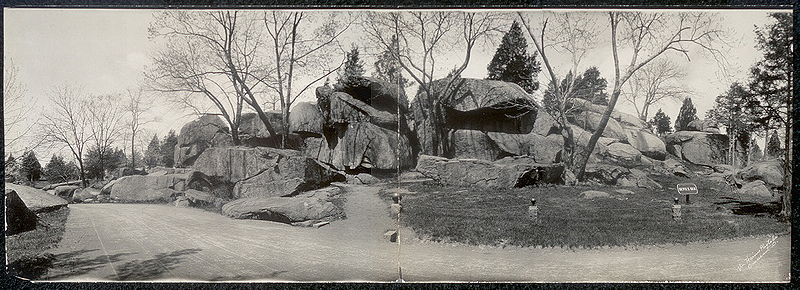
|
| Devil's Den, Gettysburg, 1909. |
Captain Smith raced to his last two guns stationed on a small knoll in the
Valley of Death: "I run with all speed in me and open fire with these two guns on the troops coming through the gorge. Their
battle flag drops three times from the effect of our canister. Their line wavers and seeks shelter in the woods, but in a
moment they return in a solid mass. The 6th New Jersey moves forward across my front, then the 40th New York passes through
the park of horses and carriages stationed near (our) position and attacks Benning's Brigade."
| The large rocks afforded shelter to both sides |
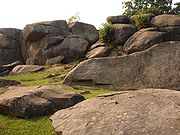
|
| Devil's Den, Gettysburg, 2005 |
Between Devil's Den and Big Round Top the valley narrowed into a boulder-choked
gorge cut by a slow moving stream called Plum Run. Rushed into the marshy valley, Union infantry battled Alabama and Georgia
troops who had swept around the Den to threaten the Union rear. With sword in hand, Colonel William F. Perry ordered his 44th
Alabama Infantry to charge through the gorge: "I received an order to capture the battery at the Devil's Den. I at once resolved
to make the attack from the woods south of the battery. My regiment, which was near the center, was thrown to the left by
an oblique march... wheeled so as to face to the north, and at once moved upon the point of attack. As the line emerged from
the woods into the open space, a sheet of flame burst from the rocks less than a hundred yards away. A few scattering shots
in the beginning gave warning in time for my men to fall flat, and thus largely escape the effect of the main volley. No language
can express the intensity of the solicitude with which I surveyed the strange, wild situation which suddenly burst upon my
view. Before the enemy had time to reload their guns a decision was made. Leaping over my prostrate line, I shouted the order
'Forward!' and started for the rocks. The response was a bound, a yell, and a rush..."
| Final Day, Battle of Gettysburg |
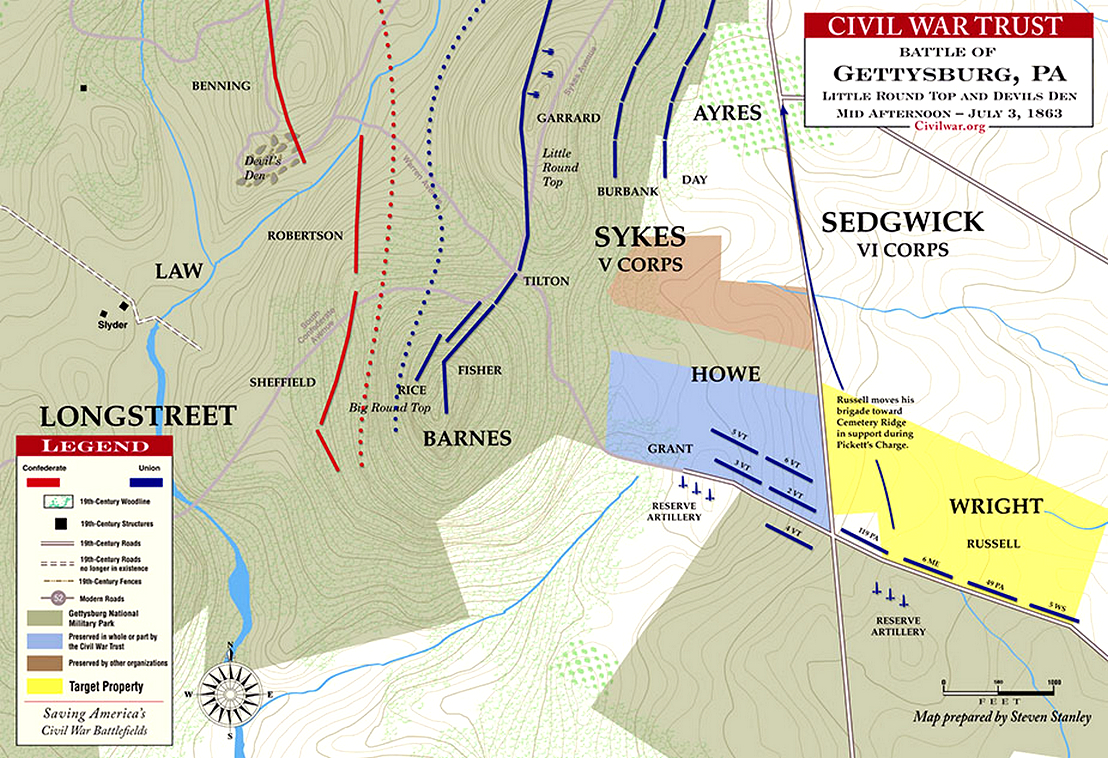
|
| Devil's Den, Third and Final Day, Battle of Gettysburg, July 3, 1863 |
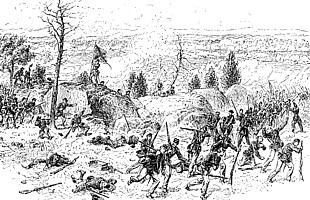
(Right) Union retreat from Devil's Den; drawn by Alfred Waud after
the battle. Battles and Leaders.
The battle lines surged back and forth until the outnumbered Union troops
were forced to retreat. One wing of 44th Alabama rushed to the summit of Devil's Den where Major George Cary planted the regiment's
flag among the boulders. "A few minutes later," Colonel Perry recalled, "the Major found me among the rocks near the foot
of the hill, prostrated by heat and excessive exertion (and) exhibited an armful of swords as trophies of his victory." In
the hands of the Confederates, Devil's Den soon became a haven for Confederate sharpshooters who practiced their deadly craft on Union targets on Little Round Top. As the battle for Devil's Den raged, the last brigade of General Hood's Division charged toward the Wheatfield.
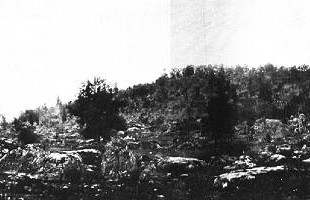
(Left) Little Round Top from Devil's Den, taken by Timothy O'Sullivan
on July 6, 1863. Library of Congress.
After the battle, the area between Devil's Den and the Round Tops was nicknamed
"The Slaughter Pen," and Plum Run Valley was referred to as "The Valley of Death." The names have remained to this very
day. Dead of both armies littered the landscape and it was over a week after the battle ended before all of the bodies were
buried. Twenty years later this area had become one of the most heavily visited sites on the battlefield. Hundreds of visitors
tramped over the area and thrilled themselves climbing over the large boulders of Devil's Den or exploring the small coves
of Plum Run. Gettysburg photographer William Tipton established a photo gallery here at the Slaughter Pen where he sold battlefield
photos to these early tourists and took their images perched among the boulders in Devil's Den. Tipton was later contracted
to photograph the work performed by the park commission of the United States War Department, which laid out the avenues and
placed many of the position markers in the park. By the turn of the century, a group of entrepreneurs had constructed the
"Gettysburg Electric Railway" through this portion of the battlefield. The rail line transported tourists aboard an electric
trolley car to and around Devil's Den, through the Valley of Death, and across the base of Little Round Top. The controversial
trolley was finally removed after 1915, but the old rail bed is still visible today.
| Devil's Den, Battle of gettysburg |
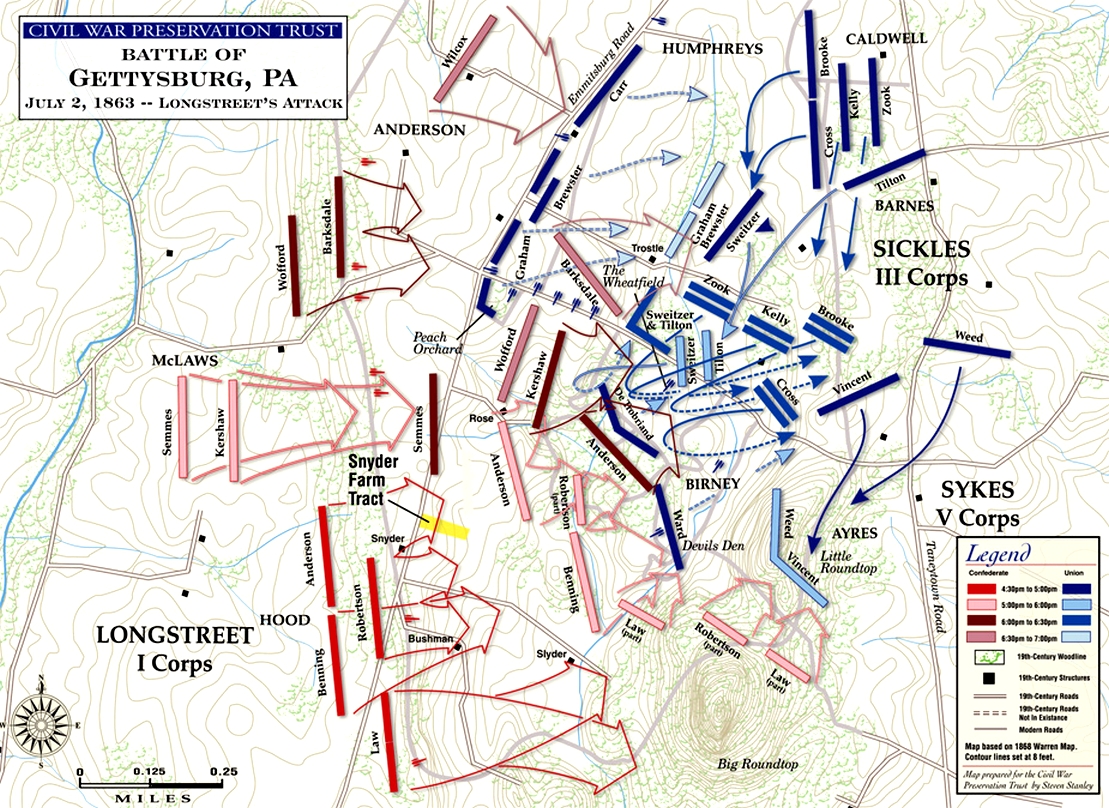
|
| Battle of Devil's Den, Battle of gettysburg, July 2, 1863 |
Analysis
Devil's Den was the extreme left of the III Corps line, manned by the large
brigade (six regiments and two companies of sharpshooters, 2,200 men in all) of Brigadier General J. H. Hobart Ward, in Maj.
Gen. David B. Birney's division. It was the southern end of Houck's Ridge, a modest elevation on the northwest side of Plum
Run Valley, made distinctive by piles of huge boulders. These boulders were not the direct avenue of approach used by the
Confederates. The 3rd Arkansas and the 1st Texas drove through Rose Woods and hit Ward's line head-on. His troops had lacked
the time or inclination to erect breastworks, and for over an hour both sides participated in a standup fight of unusual ferocity.
In the first 30 minutes, the 20th Indiana lost more than half of its men. Its colonel, John Wheeler, was killed and its lieutenant
colonel wounded. The 86th New York also lost its commander. The commander of the 3rd Arkansas fell wounded, one of 182 casualties
in his regiment.
Meanwhile, the two regiments from Law's brigade that had split from the
column advancing to the Round Tops pushed up Plum Run Valley and threatened to turn Ward's flank. Their target was the 4th
Maine and the 124th New York, defending the 4th New York Independent artillery battery commanded by Captain James Smith, whose
fire was causing considerable disruption in Law's brigade's advance. The pressure grew great enough that Ward needed to call
the 99th Pennsylvania from his far right to reinforce his left. The commander of the 124th New York, Colonel Augustus Van
Horne Ellis, and his major, James Cromwell, decided to counterattack. They mounted their horses despite the protests of soldiers
who urged them to lead more safely on foot. Maj. Cromwell said, "The men must see us today." They led the charge of their
"Orange Blossoms" regiment to the west, down the slope of Houck's Ridge through a triangular field surrounded by a low stone
fence, sending the 1st Texas reeling back 200 yards. But both Colonel Ellis and Major Cromwell were shot dead as the Texans
rallied with a massed volley; and the New Yorkers retreated to their starting point, with only 100 survivors from the 283
they started with. As reinforcements from the 99th Pennsylvania arrived, Ward's brigade retook the crest.
The second wave of Hood's assault was the brigades of Henry Benning and
George "Tige" Anderson. They detected a gap in Birney's division line: to Ward's right, there was a considerable gap before
the brigade of Régis de Trobriand began. Anderson's line smashed into Trobriand and the gap at the southern edge of the Wheatfield.
Trobriand wrote that the Confederates "converged on me like an avalanche, but we piled all the dead and wounded men in our
front." The Union defense was fierce, and Anderson's brigade pulled back; its commander was wounded in the leg and was carried
from the battle.
Two of Benning's Confederate regiments, the 2nd and 17th Georgia, moved
down Plum Run Valley around Ward's flank. They received murderous fire from the 99th Pennsylvania and Hazlett's battery on
Little Round Top, but they kept pushing forward. Capt. Smith's New York battery was under severe pressure from three sides,
but its supporting infantry regiments were suffering severe casualties and could not protect it. Three 10-pound Parrott rifles
were lost to the 1st Texas, and they were used against Union troops the next day.
| Devil's Den, Battle of Gettysburg |

|
| Hood's Assault on Devil's Den, July 2, 1863 |
Birney scrambled to find reinforcements. He sent the 40th New York and 6th
New Jersey from the Wheatfield into Plum Run Valley to block the approach into Ward's flank. They collided with Benning's
and Law's men in rocky, broken ground that the survivors would remember as the "Slaughter Pen". (Plum Run itself was known
as "Bloody Run"; Plum Run Valley as the "Valley of Death".) Col. Thomas W. Egan, commanding the 40th New York, was called
on by Smith to recover his guns. The men of the "Mozart" regiment slammed into the 2nd and 17th Georgia regiments, with initial
success. As Ward's line along Houck's Ridge continued to collapse, the position manned by the 40th became increasingly untenable.
However, Egan pressed his regiment onward, according to Col. Wesley Hodges
of the 17th Georgia, launching seven attacks against the Confederate positions within the boulders of Slaughter Pen and Devil's
Den. As the men of the 40th fell back under relentless pressure, the 6th New Jersey covered their withdrawal and lost a third
of its men in the process.
The pressure on Ward's brigade was eventually too great, and he was forced
to call for a retreat. Hood's division secured Devil's Den and the southern part of Houck's Ridge. The center of the fighting
shifted to the northwest, to Rose Woods and the Wheatfield, while five regiments under Evander Law assaulted Little Round
Top to the east. Benning's men spent the next 22 hours on Devil's Den, firing across the Valley of Death on Union troops massed
on Little Round Top.
The assaults by Hood's brigades were classic, tough infantry fights. Of
2,423 Union troops engaged, there were 821 casualties (138 killed, 548 wounded, 135 missing); the 5,525 Confederates lost
1,814 (329, 1,107, 378).
Sources: National Park Service; Gettysburg National Military Park; Library
of Congress; maps courtesy Civil War Trust, civilwartrust.org; National Archives; Official Records of the Union and Confederate
Armies.
Recommended Reading:
Devil's Den: A History and Guide. Description: One of the most fascinating aspects of the Battle of Gettysburg comes
alive in this volume, Devil’s Den: A History and Guide. Don’t let the word “Guide” in the
title make you think that it is a pseudo-tour guide booklet, because this work is an exhaustive history regarding that hotly
contested and fiercely fought area named “The Devil’s Den.“ The authors are both licensed battlefield guides,
which adds that personal touch to the book and makes for a lively read. In addition, rare period photographs and a guided
tour section enhance this enlightening and entertaining book. Continued below...
Attention to detail has been applied
with the inclusion of numerous photos and an exhaustive history about the Devil's Den. With few books being dedicated
to this historic battle and battlefield, this book belongs in every Civil War buff’s library…
Recommended Reading: Gettysburg--The Second Day, by Harry W. Pfanz (624 pages). Description: The second day's fighting at Gettysburg—the
assault of the Army of Northern Virginia against the Army of the Potomac
on 2 July 1863—was probably the critical engagement of that decisive battle and, therefore, among the most significant
actions of the Civil War. Harry Pfanz, a former historian at Gettysburg
National Military Park,
has written a definitive account of the second day's brutal combat. He begins by introducing the men and units that were to
do battle, analyzing the strategic intentions of Lee and Meade as commanders of the opposing armies, and describing the concentration
of forces in the area around Gettysburg. He then examines
the development of tactical plans and the deployment of troops for the approaching battle. But the emphasis is on the fighting
itself. Pfanz provides a thorough account of the Confederates' smashing assaults—at Devil's Den and Little Round Top,
through the Wheatfield and the Peach Orchard, and against the Union center at Cemetery Ridge. He also details the Union defense
that eventually succeeded in beating back these assaults, depriving Lee's gallant army of victory. Continued below...
Pfanz analyzes
decisions and events that have sparked debate for more than a century. In particular he discusses factors underlying the Meade-Sickles
controversy and the questions about Longstreet's delay in attacking the Union left. The narrative is also enhanced by thirteen superb maps, more than eighty illustrations,
brief portraits of the leading commanders, and observations on artillery, weapons, and tactics that will be of help even to
knowledgeable readers. Gettysburg—The Second Day
is certain to become a Civil War classic. What makes the work so authoritative is Pfanz's mastery of the Gettysburg literature and his unparalleled knowledge of the ground on which the fighting
occurred. His sources include the Official Records, regimental histories and personal reminiscences from soldiers North and
South, personal papers and diaries, newspaper files, and last—but assuredly not least—the Gettysburg battlefield.
Pfanz's career in the National Park Service included a ten-year assignment as a park historian at Gettysburg. Without doubt, he knows the terrain of the battle as well as he knows the battle
itself.
Recommended Reading: Twilight at Little Round Top: July 2, 1863, The Tide Turns at Gettysburg (Hardcover). Description: "Few military episodes of the Civil War have attracted as much attention as
the struggle for Little Round Top on the second day of Gettysburg.
This judicious and engaging book navigates confidently through a welter of contradictory testimony to present a splendid account
of the action. It also places events on Little Round Top, which often are exaggerated, within the broader sweep of the battle.
All readers interested in the battle of Gettysburg will read
this book with enjoyment and profit." —Gary W. Gallagher, author of The Confederate War. "Here is the real story of
the epic fight for Little Round Top, shorn of the mythology long obscuring this pivotal Gettysburg
moment. A vivid and eloquent book." —Stephen W. Sears, author of Gettysburg.
Continued below…
"In his beautifully
written narrative, Glenn LaFantasie tells the story of the battle for Little Round Top from the perspective of the soldiers
who fought and died in July 1863. Using well-chosen quotes from a wide variety of battle participants, TWILIGHT puts the reader
in the midst of the fight—firing from behind boulders with members of the 4th Alabama, running up the hillside into battle with the men of the 140th New York, and watching in horror as far too many men die. This book offers an elegy to the
courage of those men, a meditation on the meaning of war, and a cautionary tale about the sacrifices nations ask of their
soldiers and the causes for which those sacrifices are needed." --Amy Kinsel, Winner of the 1993 Allan Nevins Prize for From
These Honored Dead: Gettysburg in American Culture
"Little Round
Top has become iconic in Civil War literature and American memory. In the emotional recollection of our great war, if there
was one speck on the landscape that decided a battle and the future of a nation, then surely this was it. The story of the
July 2, 1863 struggle for that hill outside Gettysburg goes
deeper into our consciousness than that, however. The men who fought for it then and there believed it to be decisive, and
that is why they died for it. Glenn W. LaFantasie's TWILIGHT AT LITTLE ROUND TOP addresses that epic struggle, how those warriors
felt then and later, and their physical and emotional attachment to a piece of ground that linked them forever with their
nation's fate. This is military and social history at its finest." --William C. Davis, author of Lincoln's Men and An Honorable Defeat.
Recommended Reading: The Artillery
of Gettysburg (Hardcover). Description: The battle of Gettysburg in July 1863, the apex of the Confederacy's final major invasion of the North,
was a devastating defeat that also marked the end of the South's offensive strategy against the North. From this battle until
the end of the war, the Confederate armies largely remained defensive. The Artillery of Gettysburg is a thought-provoking
look at the role of the artillery during the July 1-3, 1863 conflict. Continued below...
During the Gettysburg campaign, artillery had already gained the respect
in both armies. Used defensively, it could break up attacking formations and change the outcomes of battle. On the offense,
it could soften up enemy positions prior to attack. And even if the results were not immediately obvious, the psychological
effects to strong artillery support could bolster the infantry and discourage the enemy. Ultimately, infantry and artillery
branches became codependent, for the artillery needed infantry support lest it be decimated by enemy infantry or captured.
The Confederate Army of Northern Virginia had modified its codependent command system in February 1863. Prior to that, batteries
were allocated to brigades, but now they were assigned to each infantry division, thus decentralizing its command structure
and making it more difficult for Gen. Robert E. Lee and his artillery chief, Brig. Gen. William Pendleton, to control their
deployment on the battlefield. The Union Army of the Potomac had superior artillery capabilities
in numerous ways. At Gettysburg, the Federal artillery had
372 cannons and the Confederates 283. To make matters worse, the Confederate artillery frequently was hindered by the quality
of the fuses, which caused the shells to explode too early, too late, or not at all. When combined with a command structure
that gave Union Brig. Gen. Henry Hunt more direct control--than his Southern counterpart had over his forces--the Federal
army enjoyed a decided advantage in the countryside around Gettysburg. Bradley
M. Gottfried provides insight into how the two armies employed their artillery, how the different kinds of weapons functioned
in battle, and the strategies for using each of them. He shows how artillery affected the “ebb and flow” of battle
for both armies and thus provides a unique way of understanding the strategies of the Federal and Union
commanders.
Recommended Reading: The Maps of Gettysburg:
The Gettysburg Campaign, June 3 - July 13, 1863
(Hardcover). Description: More academic and photographic
accounts on the battle of Gettysburg exist than for all other
battles of the Civil War combined-and for good reason. The three-days of maneuver, attack, and counterattack consisted of
literally scores of encounters, from corps-size actions to small unit engagements. Despite all its coverage, Gettysburg remains one of the most complex and difficult to understand battles of the war.
Author Bradley Gottfried offers a unique approach to the study of this multifaceted engagement. The Maps of Gettysburg plows
new ground in the study of the campaign by breaking down the entire campaign in 140 detailed original maps. These cartographic
originals bore down to the regimental level, and offer Civil Warriors a unique and fascinating approach to studying the always
climactic battle of the war. Continued below...
The Maps of
Gettysburg offers thirty "action-sections" comprising the entire campaign. These include the march to and from the battlefield,
and virtually every significant event in between. Gottfried's original maps further enrich each "action-section." Keyed to
each piece of cartography is detailed text that includes hundreds of soldiers' quotes that make the Gettysburg
story come alive. This presentation allows readers to easily and quickly find a map and text on virtually any portion of the
campaign, from the great cavalry clash at Brandy Station on June 9, to the last Confederate withdrawal of troops across the
Potomac River on July 15, 1863. Serious students of the battle will appreciate the extensive
and authoritative endnotes. They will also want to bring the book along on their trips to the battlefield… Perfect for
the easy chair or for stomping the hallowed ground of Gettysburg,
The Maps of Gettysburg promises to be a seminal work that belongs on the bookshelf of every serious and casual student of
the battle.
Recommended Reading: Gettysburg: A Testing of Courage. Description:
America's Civil War raged for more than four years, but it is the three
days of fighting in the Pennsylvania countryside in July
1863 that continues to fascinate, appall, and inspire new generations with its unparalleled saga of sacrifice and courage.
From Chancellorsville, where General Robert E. Lee launched his high-risk campaign into the North, to the Confederates' last
daring and ultimately-doomed act, forever known as Pickett's Charge, the battle of Gettysburg gave the Union army a victory
that turned back the boldest and perhaps greatest chance for a Southern nation. Continued below...
Now, acclaimed
historian Noah Andre Trudeau brings the most up-to-date research available to a brilliant, sweeping, and comprehensive history
of the battle of Gettysburg that sheds fresh light on virtually every aspect of it. Deftly balancing his own
narrative style with revealing firsthand accounts, Trudeau brings this engrossing human tale to life as never before.
Recommended Reading:
The History Buff's Guide to Gettysburg (Key People, Places, and Events) (Key People, Places, and Events).
Description: While most history books are dry monologues
of people, places, events and dates, The History Buff's Guide is ingeniously written and full of not only first-person accounts
but crafty prose. For example, in introducing the major commanders, the authors basically call Confederate Lt. Gen. Richard
S. Ewell a chicken literally. Continued
below...
'Bald, bug-eyed,
beak-nosed Dick Stoddard Ewell had all the aesthetic charm of a flightless foul.' To balance things back out a few pages later,
they say federal Maj. Gen. George Gordon Meade looked like a 'brooding gargoyle with an intense cold stare, an image in perfect
step with his nature.' Although it's called a guide to Gettysburg, in my opinion, it's an authoritative guide to
the Civil War. Any history buff or Civil War enthusiast or even that casual reader should pick it up.
|

